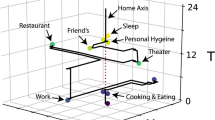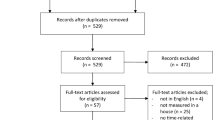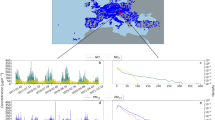Abstract
For an actively emitting source such as cooking or smoking, indoor measurements have shown a strong “proximity effect” within 1 m. The significant increase in both the magnitude and variation of concentration near a source is attributable to transient high peaks that occur sporadically—and these “microplumes” cause great uncertainty in estimating personal exposure. Recent field studies in naturally ventilated rooms show that close-proximity concentrations are approximately lognormally distributed. We use the autocorrelated random walk method to represent the time-varying directionality of indoor emissions, thereby predicting the time series and frequency distributions of concentrations close to an actively emitting point source. The predicted 5-min concentrations show good agreement with measurements from a point source of CO in a naturally ventilated house—the measured and predicted frequency distributions at 0.5- and 1-m distances are similar and approximately lognormal over a concentration range spanning three orders of magnitude. By including the transient peak concentrations, this random airflow modeling method offers a way to more accurately assess acute exposure levels for cases where well-defined airflow patterns in an indoor space are not available.
This is a preview of subscription content, access via your institution
Access options
Subscribe to this journal
Receive 6 print issues and online access
$259.00 per year
only $43.17 per issue
Buy this article
- Purchase on Springer Link
- Instant access to full article PDF
Prices may be subject to local taxes which are calculated during checkout





Similar content being viewed by others
References
Rodes C, Kamens R, Wiener R . The significance and characteristics of the personal activity cloud on exposure assessment measurements for indoor contaminants. Indoor Air 1991; 2: 123–145.
Furtaw J, Pandian MD, Nelson DR, Behar JV . Modeling indoor air concentrations near emission sources in imperfectly mixed rooms. J Air Waste Manage Assoc 1996; 46: 861–868.
McBride SJ, Ferro A, Ott WC, Switzer P, Hildemann LM . Investigations of the proximity effect for pollutants in the indoor environment. J Expo Anal Env Epid 1999; 9: 602–621.
Ott WR, McBride SJ, Switzer P In: Levin H (ed). Indoor Air ’02, Proceedings of the Eighth International Conference on Indoor Air Quality and Climate,. Monterey, CA, USA. 2002 pp 229–234.
Ferro AR, Hildemann LM, McBride SJ, Ott WR, Switzer P In: Brebbia CA, Jacobson M, Power H (eds). Air Pollution VII. WIT Press: Southampton, UK. 1999 pp 487–496.
Ferro AR, Kopperud RJ, Hildemann LM . Elevated personal exposure to particulate matter from human activities in a residence. J Expo Anal Env Epid 2004; 14: S34–S40.
Ferro AR, Klepeis NE, Ott WR, Nazaroff WW, Hildemann LM, Switzer P . Effect of interior door position on room-to-room differences in residential pollutant concentrations after short-term releases. Atmos Environ 2009; 43: 706–714.
Acevedo-Bolton V, Cheng KC, Jiang RT, Ott WR, Klepeis NE, Hildemann LM . Measurement of the proximity effect for indoor air pollutant sources in two homes. J Environ Monitor 2012; 14: 94–104.
McBride SJ . A marked point process model for the source proximity effect in the indoor environment. J Am Stat Assoc 2002; 97: 683–691.
Hayes SR . Use of an indoor air quality model (IAQM) to estimate indoor ozone levels. J Air Waste Manage Assoc 1991; 41: 161–170.
Keil CB . The development and evaluation of an emission factor for toluene parts-washing process. Am Ind Hyg Assoc J 1998; 59: 14–19.
Ott WR, Klepeis NE, Switzer P . Analytical solutions to compartmental indoor air quality models with application to environmental tobacco smoke concentrations measured in a house. J Air Waste Manage Assoc 2003; 53: 918–936.
Wadden RA, Scheff PA, Franke JE . Emission factors for trichloroethylene vapor degreasers. Am Ind Hyg Assoc J 1989; 50: 496–500.
Conroy LM, Wadden RA, Scheff PA, Franke JE, Keil CB . Workplace emission factors for Hexavalent Chromium plating. Appl Occup Environ Hyg 1995; 10: 620–627.
Demou E, Hellweg S, Wilson MP, Hammond SK, Mckone TE . Evaluating indoor exposure modeling alternatives for LCA: a case study in the vehicle repair industry. Environ Sci Technol 2009; 43: 5804–5810.
Cheng KC, Acevedo-Bolton V, Jiang RT, Klepeis NE, Ott WR, Fringer OB et al. Modeling exposure close to air pollution sources in naturally ventilated residences: association of turbulent diffusion coefficient with air change rate. Environ Sci Technol 2011; 45: 4016–4022.
Drivas PJ, Valberg PA, Murphy BL, Wilson R . Modeling indoor air exposure from short-term point source releases. Indoor Air 1996; 6: 271–277.
Jayjock MA, Chaisson CF, Arnold S, Dederick EJ . Modeling framework for human exposure assessment. J Expo Sci Environ Epidemiol 2007; 17: S81–S89.
Nicas M In: Keil CB, Simmons CE, Anthony TR (eds). Mathematical Models for Estimating Occupational Exposure to Chemicals. AIHA Press: Fairfax, VA, USA. 2009 pp 53–65.
Persoons R, Maitre A, Bicout DJ . Modelling the time profiles of organic solvent concentrations for occupational exposure assessment purposes. Ann Occup Hyg 2011; 55: 421–435.
Scheff PA, Friedman RL, Franke JE, Conroy LM, Wadden RA . Source activity modeling of Freon emissions from open-top vapor degreasers. Appl Occup Environ Hyg 1992; 7: 127–134.
Nicas M . Modeling turbulent diffusion and advection of indoor air contaminants by Markov Chains. Am Ind Hyg Assoc J 2001; 62: 149–158.
Limpert E, Stahel WA, Abbt M . Lognormal distributions across the sciences: keys and clues. BioScience 2001; 51: 341–352.
Kitanidis PK . Particle-tracking equations for the solution of the advection-dispersion equation with variable coefficients. Water Resour Res 1994; 30: 3225–3227.
Charbeneau RJ . Groundwater Hydraulics and Pollutant Transport. Prentice-Hall: Upper Saddle River, NJ, USA. 2000 pp 431–435.
Siegel DA, Kinlan BP, Gaylord B, Gaines SD . Lagrangian descriptions of marine larval dispersion. Mar Ecol-Prog Ser 2003; 260: 83–96.
Arritt RW, Clark CA, Goggi AS, Sanchez HL, Westgate ME, Riese JM . Lagrangian numerical simulations of canopy air flow effects on maize pollen dispersal. Field Crop Res 2007; 102: 151–162.
Wang J, Shen Y . Modeling oil spills transportation in seas based on unstructured grid, finite-volume, wave-ocean model. Ocean Model 2010; 35: 332–344.
Seinfeld JH, Pandis SN . Atmospheric Chemistry and Physics. John Wiley & Sons: Hoboken, NJ, USA. 2006 pp 412–416.
Crank J . The Mathematics of Diffusion. Oxford University Press: New York, NY, USA. 1975 pp 29–32.
Israelsson PH, Kim YD, Adams EE . A comparison of three Lagrangian approaches for extending near field mixing calculations. Environ Model Softw 2006; 21: 1631–1649.
Cheng KC, Acevedo-Bolton V, Jiang RT, Klepeis NE, Ott WR, Hildemann LM . Model-based reconstruction of the time response of electrochemical air pollutant monitors to rapidly varying concentrations. J Environ Monitor 2010; 12: 846–853.
Massman WJ . A review of the molecular diffusivities of H2O, CO2, CH4, CO, O3, SO2, NH3, N2O, NO, and NO2 in air, O2 and N2 near STP. Atmos Environ 1998; 32: 1111–1127.
Rim D, Novoselac A . Transport of particulate and gaseous pollutants in the vicinity of a human body. Build Environ 2009; 44: 1840–1849.
Chang T-J, Hsieh Y-F, Kao H-M . Numerical investigation of airflow pattern and particulate matter transport in naturally ventilated multi-room buildings. Indoor Air 2006; 16: 136–152.
Salmanzadeh M, Zahedi Gh, Ahmadi G, Marr DR, Glauser M . Computational modeling of effects of thermal plume adjacent to the body on the indoor airflow and particle transport. J Aerosol Sci 2012; 53: 29–39.
Choi J-I, Edwards JR . Large eddy simulation and zonal modeling of human-induced contaminant transport. Indoor Air 2008; 18: 233–249.
Author information
Authors and Affiliations
Corresponding author
Ethics declarations
Competing interests
The authors declare no conflict of interest.
Additional information
Supplementary Information accompanies the paper on the Journal of Exposure Science and Environmental Epidemiology website
Supplementary information
Rights and permissions
About this article
Cite this article
Cheng, KC., Acevedo-Bolton, V., Jiang, RT. et al. Stochastic modeling of short-term exposure close to an air pollution source in a naturally ventilated room: An autocorrelated random walk method. J Expo Sci Environ Epidemiol 24, 311–318 (2014). https://doi.org/10.1038/jes.2013.63
Received:
Revised:
Accepted:
Published:
Issue Date:
DOI: https://doi.org/10.1038/jes.2013.63



